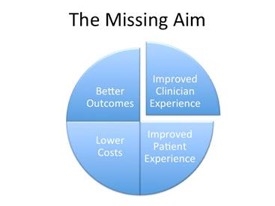Duke Integrative Medicine Hits on Key “Quadruple Aim” Targets
By John Weeks
by John Weeks, Publisher/Editor of The Integrator Blog News and Reports
“We’ve had a very good year.” So commented Adam Perlman, MD, MPH (pictured right) in a recent webinar on leadership in integrative medicine.  Perlman directs Duke Integrative Medicine and is also the director of the highly-regarded Leadership Program in Integrative Healthcare at Duke University certificate program. Under both positions, the recent outcomes from service delivery at Duke Integrative Medicine bode well for integrative medicine as organized medicine’s ascends from a focus on production to the “value-based” era of the so-called Quadruple Aim.
Perlman directs Duke Integrative Medicine and is also the director of the highly-regarded Leadership Program in Integrative Healthcare at Duke University certificate program. Under both positions, the recent outcomes from service delivery at Duke Integrative Medicine bode well for integrative medicine as organized medicine’s ascends from a focus on production to the “value-based” era of the so-called Quadruple Aim.
I interviewed Perlman following the webinar. I wanted to know what data supports his assertion and how did the changes come to pass. Colleagues and I had previously surveyed leaders of integrative medicine centers as part of the Project for Integrative Health and the Triple Aim. We found perceptions of growing alignment among center directors with their sponsoring systems as delivery organizations began to focus more on the values in the now “Quadruple Aim”: better patient experience, higher practitioner satisfaction, enhanced population health and lower per capita costs.
 Early integrative business experience had proved misaligned with medical organizations in which success was measured on production of procedures and profits rather than on health and system/cost outcomes. Would the Duke experience support this emerging alignment?
Early integrative business experience had proved misaligned with medical organizations in which success was measured on production of procedures and profits rather than on health and system/cost outcomes. Would the Duke experience support this emerging alignment?
The data Perlman shared reflected advances in two of the four quadruple aims. On the Press Ganey measure of patient satisfaction, patients at Duke Integrative medicine scored care as a 96.2. This was a bump above the prior year. It put the patient experience in the 97th percentile among scored medical organizations and significantly above most departments at Duke.
A separate measure of “work culture and engagement” is meant to measure practitioner experience. The Duke Health and Wellness division of which the integrative medicine center is part scored “the highest of any department at Duke.” In this area, they bumped up 10 percent to a 4.43. This placed them in the 95th percentile of academic health centers utilizing the measure.
Perlman also spoke to the old-school measure of simple production of services. The number of visits at Duke Integrative Medicine jumped improved significantly. “We were up over 50 percent in 2015, from 9,796 visits to 14,728.” The growth was in “all areas” he said, whether it was the integrative consults or the delivery of individual therapies. In addition, in their concierge-based integrative primary care model – one of the first in an academic health system in the U.S. – membership jumped to 685 members. This was up 25 percent from the prior year.
“So,” added Perlman, “our scores improved in all three domains.”
Asked to what he attributed the positive outcomes, Perlman pointed to a conscious focus on strengthening the work culture. They used ![]() strategies like a “speed-dating” technique to strengthen the relationships between the various practitioners. He personally took more time individually connecting with members of his team. “When practitioners are happier, then patients are happier, and scores go up.”
strategies like a “speed-dating” technique to strengthen the relationships between the various practitioners. He personally took more time individually connecting with members of his team. “When practitioners are happier, then patients are happier, and scores go up.”
Perlman, who was the founder 20 years ago of an early health system-based integrative center at St. Barnabas in New Jersey, recalls the era of troubled business models. “We’re not in the black yet,” he said, “but we’re doing better financially every year.” With a nod to the parts of the Quadruple Aim that the Duke integrative center is positively impacting, he concludes: “I’m trying to get [system leadership] to expand their idea of ‘ROI’ to ‘VOI.’” From “return-on-investment,” he clarified, to “value-on-investment.”
Comment: Bob Dylan has a song called, simply “Gotta Serve Somebody”. In Dylan’s polarized framing, “it may be the devil or it may be the lord/ But you’re gonna have to serve somebody.”
Medical delivery organization leaders charged with navigating the transition from high production to high value have famously “one foot on the dock, and one on the boat.” They are serving two masters – trying continue to generate more revenue while also, for instance, lowering per capital costs. This tension can’t feel too comfortable down there in the lowest chakras.
The veteran Perlman is clearly also speaking to both two masters. He couples the Press Gainey and practitioner culture – VOI outcomes – with the rapid jump in patient visits that directly connect to productivity-oriented ROI.
It would be nice to have some measures of Duke Integrative Medicine’s impact on the Quadruple Aim area of lowering per capita costs. Because if the integrative services are successfully keeping people from needing more expensive downstream imaging and surgical services then, well, let’s see how far the boat will move from the dock. For now, congratulations to Perlman and his team.
















